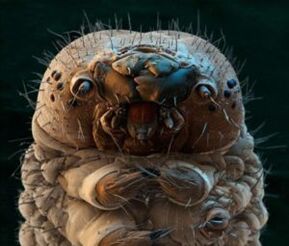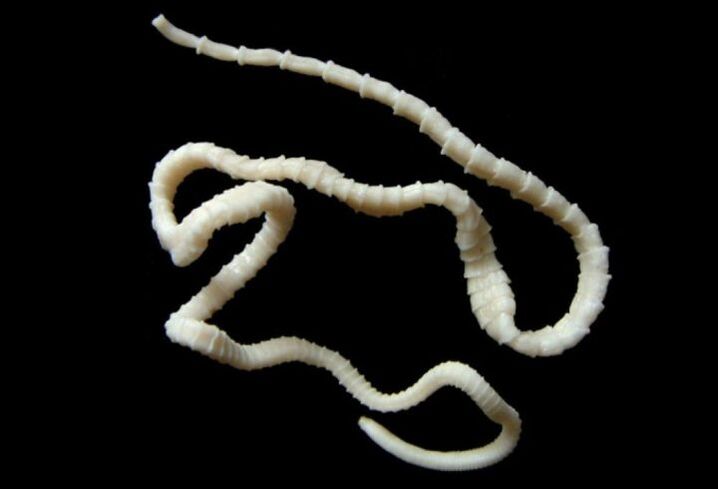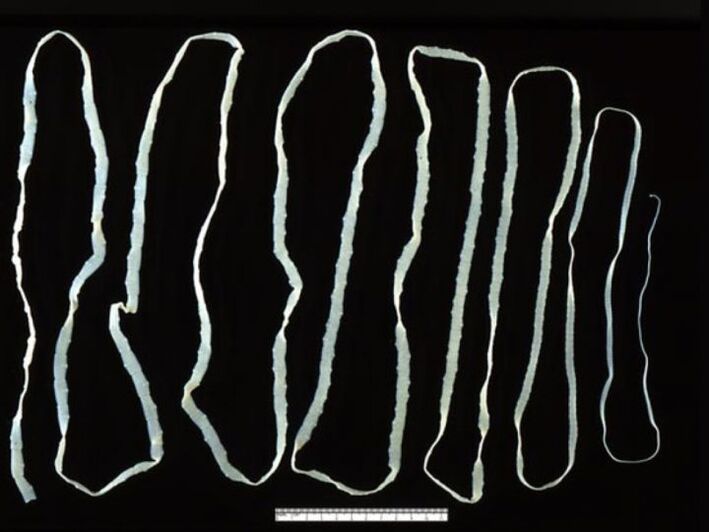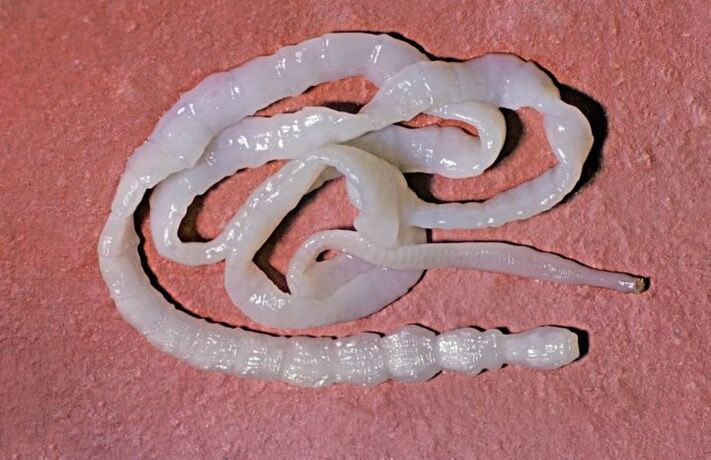
All types of parasites in the human body have adverse effects on their health. They infect organs, feed on nutrients needed for human life, and release harmful toxic substances. Therefore, it is very important to remove them in time.
The human body is affected by various parasites. Some parasites live in the body, while others live on its surface. Their size, the way they enter the body, and the characteristics of important activities are different.
What parasites exist in the human body? How to get rid of them? What are the preventive measures? These issues will be discussed below.
Parasite classification
Human parasites are very common and fall into the following categories:
- Internal parasitesThe organisms that are parasitic in the human body are called. This group is divided into protozoa (consisting of single cells) and worms (worms). The simplest parasites in the human body are amoeba, lamb, trichomoniasis, and toxoplasma. As for worms, they are divided into roundworms (nematodes), flatworms and tapeworms.
- Ectoparasites-These are creatures that parasitize the surface of the human body-lice, lice, fleas, and bugs. They not only feed on human blood and cause great discomfort (bites, burns, skin wounds), but also carry quite dangerous diseases: typhus, anthrax, trypanosomiasis and others.
Single-celled parasites:
- Giardia. . . Giardiasis infection is a fecal-oral mechanism. After removing the cysts (parasites that have not yet formed and covered with a protective film) from the patient's anus, they will spread to vegetables, fruits and other foods. Cysts enter the human mouth through poor hand washing, stagnant water, and inadequately cleaned fruits and vegetables, and from there safely to the intestines, where they become adults again and multiply. The result is a vicious circle that will continue until adequate treatment is provided and sanitary measures are taken. The symptoms of the disease are weakness, fatigue, headache, diarrhea, abdominal pain and bloating. Anal itching, rash, and bronchial asthma can all occur. The pathological features are weight loss, anemia and weakened immune system. Treat with protozoan drugs. The dose is prescribed by the doctor.
- Toxoplasma gondii. . . These protozoan infections occur through contact with infected pets. In this case, humans are the intermediate host, because the parasite's sexual development cycle occurs in the animal's body. The disease is characterized by a continuous increase in body temperature to sub-fever levels, general signs of poisoning, swollen lymph nodes, and joint and muscle pain. Moreover, the functions of the gastrointestinal tract and vision are destroyed, the central nervous system may be damaged, and there are signs of heart disease and endocrine system. Complicated treatments are prescribed-tetracycline antibiotics and sulfa drugs.
- Trichomonas. . . Trichomonas is sexually transmitted, and the risk of infection caused by contact is small, but it still exists. Symptoms of the disease in women are itching, redness of the genitals, burning sensation and foam discharge. Men may have difficulty urinating and be discharged from the hospital. Treatment-anti-trichomoniasis.
Worm is an intestinal parasite
The most famous internal parasite is the pinworm. They live in the intestines and cause a disease called enteropathy. This type of parasite affects not only humans but also monkeys. People at risk-preschool children. According to statistics, half of children between the ages of 2 and 10 are diagnosed with bowel disease.

Worms spread from person to person, and you can infect the virus through any object or handshake used by the sick person. The main condition for pinworm egg transfer is not to wash hands after contact, especially before eating. Worms, or their eggs, can be carried by flies and cockroaches.
Pinworms can only live in the intestine, and they are particularly comfortable in the thinner part of the colon and cecum. To mate, the parasite chooses the ileum, from where the female crawls out of the anus and lays eggs in the anus. The symptoms of pinworms in the body are anal itching, allergies, fatigue, anemia, abdominal pain, and exhaustion.
In order to treat small intestinal helminthiasis, anthelmintics are needed. Prevention of insects is based on hand hygiene. It must be washed after visiting any public place.
Bug-round bug
Adults can reach up to 40 cm in length. Round worms live in the human intestine. The eggs hatch naturally, and then continue to grow in the soil until they enter the human body again. Dirty hands and unwashed vegetables and fruits are methods of roundworm infection. The worm eggs are covered by a shell that is insoluble in the human stomach, allowing the worms to survive and enter the intestinal tract developed by the mature individual.

C insect disease is asymptomatic for a long time. Symptoms then appear, depending on the location and stage of development of the parasite. During the first migratory stage of assimilation, the patient is worried about fever, cough, cough, rash, migraine, swollen lymph nodes, liver and spleen. In the later stages, when the parasite has entered the intestine, stool disturbances (dysentery, cholera-like symptoms, signs of typhoid fever) are observed. Pain in the abdomen, rapid weight loss and fatigue.
Wide tapeworm
This parasite is infected by fish. This is the intermediate host of the worm. It is not necessary to eat for the sake of infection, and sometimes just contact with infected fish is sufficient. This is why you must handle your hands, knives, and plates very carefully after cutting the fish.

From sick people to healthy people, worms and their larvae do not spread. The symptoms of infection are nausea, vomiting, abdominal pain, increased or decreased appetite, and indigestion. The first symptoms of the disease may appear one or two months after infection. Due to the long-term existence of this parasite in the human body, the skin is pale, headache, rapid heart rhythm, lowered blood pressure, weakness, and anemia. The purpose of treatment is to kill the worms. For this, use anthelmintics.
Cow tapeworm
Bovine tapeworm can grow up to 12 m, is a hermaphroditic, and can produce more than 100, 000 eggs, which are excreted through feces. The eggs fall into the soil and then into the plants, which are eaten by the cows. In animals, the eggs become larvae and are located in the muscles. If a person eats contaminated beef, the larvae will enter the intestines. The larvae do not spread from person to person.
The adult worm has four suction cups on its head, a neck and a body made up of thread segments. The number of segments is increasing, and mature segments can be separated from the worm and crawl out of the human intestine.

The symptoms of the disease are nausea, vomiting, indigestion, increased salivation, dizziness, weakness, nervousness, fatigue, abdominal pain of uncertain location, allergies, loss of appetite.
In order to remove cattle tapeworms from the body, there is a plan that includes three stages: preparation stage (cleansing the body), antiparasitic medication, and rehabilitation (diet, herbal medicine).
Pork tapeworm
A person can infect pork tapeworm through unclean hands, cooked meat, and dirty water. The infected person can excrete the segments and larvae of the aworm into the environment through vomit and feces.
The worm can live in the human body for up to 15-17 years. It sticks to the intestinal mucosa, and its larvae can spread to the whole body through the bloodstream and attach to any organ. If the larva enters the brain, it is especially dangerous.
Pigs are the intermediate host; people who are in regular contact with raw meat are most susceptible to this parasite. Touching and eating meat that has not been sufficiently heat-treated can infect the pork chain. In order for all the larvae of pork tapeworm to be destroyed in the meat, it must be cooked or frozen for a long time for 2-3 weeks.

Pork tapeworm can affect the small intestine, liver, brain, visual organs, muscles, etc. If the worm infects vital organs, then a person may become paralyzed or even die.
Symptoms of pork tapeworm: allergic reactions, abdominal pain, nausea and vomiting, weakness, dizziness, headache, weight loss, anal itching. Worms infect the intestinal mucosa, so the symptoms are very similar to enteritis.
The treatment method is to take drugs that have a paralyzing effect on the worms. As a result, it cannot stay in the intestinal wall and exit. However, at the same time, it emits a large amount of toxic substances, which may cause anaphylactic shock in people. Therefore, treatment can only be carried out under the supervision of a physician.
Parasites in the mouth
Parasites in the population can usually be represented by the following types:
- Trichomonas
- Oral amoeba
- Diptera larvae (oral myopathy).
The clinical manifestations may be as follows:
- allergy
- Weakness, weight loss;
- Stench in the mouth;
- A sensation of stirring in the throat;
- Itching and sweat;
- Nausea and decreased physical strength.
The worms in the mouth can damage the teeth and form purulent deposits on the mucous membranes and tongue. It is prescribed only by a doctor who considers the existing symptoms and the type of parasite. The prerequisite for treatment is to check all people in contact with the patient.
to sum up
Above, not all factors have been considered, even the most common parasites that can live inside the human body. It is important to understand the great dangers in this community: worms in the human body can cause very serious consequences and ultimately lead to the death of its owner. Therefore, it is very important to diagnose and eliminate parasites in time. As for preventive measures, they mainly include hygiene and high-quality roasting of edible meat.



































